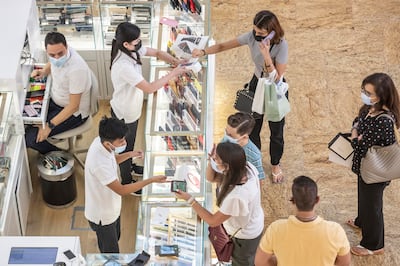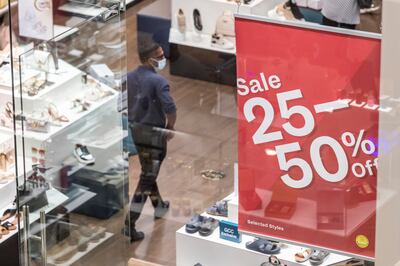The Dubai Shopping Festival started this week. Now in its 27th year, the shopping festival is a reminder that online retail is a definite attraction for shoppers in the Middle East market, but the charm of in-store shopping experience continues to hold its own. This is an opportunity for retailers and brands, provided they are tuned to changing market dynamics and the evolving needs of customers.
A PWC report indicates that a growing number of consumers in the UAE are making purchases via smartphones (53 per cent), computers (39 per cent) and tablets (31 per cent). The UAE’s retail e-commerce market reached $3.9billion in 2020, reporting a 53 per cent year-on-year increase. E-commerce is growing, accounting for an 8 per cent share of the retail market during the same year, according to Dubai Chamber of Commerce and Industry. Interestingly, a significant proportion of consumers compare prices online across brands, and then step into a store to make the purchase.

In the new retail reality, the consumer is more aware and empowered than he or she previously was. Customers know what they want, where they will find it and the cost of it. Therefore, retailers can no longer take customer loyalty for granted. Customers are now loyal to trends, not necessarily to brands. Hence, retailers must respond to these trends and treat their customers to perks, a mix of online and offline ones, such as exclusive access to private brick-and-mortar events and discounts online.
Despite the online buying trend, it is not time for retailers to shun brick-and-mortar stores completely and embrace only the online medium. A hybrid model is the way to go. This means companies must engage with consumers digitally much even they arrive at the store to make a purchase.
In the Middle East, the major growth areas in the retail sector, driven by social media influencers, are: beauty “athleisure” or athletic leisurewear, wellness and healthy eating.
Retailers operating in these areas are sitting on a treasure trove of customer data. They must leverage the power of data and multi-channel analytics to understand how consumers interact with their brands and with specific product lines, whether in store, on the website or via mobile phones. The brands that are most responsive and proactive in this respect are most likely to win the customer’s loyalty.
Let's look at some technology solutions that aid retailers to engage with customers.


When customers use smartphones to shop, they leave behind a trail of breadcrumbs that retailers can pick up to understand customer behaviour: do customers like the brand? Are they sensitive to the brand’s pricing? Is the app experience good? This sort of information can be obtained with “predictive segmentation”, using a model called RFM – a combination of the cues of recency, frequency and monetary.
Retailers can rely on machine learning algorithms to analyse customer data and understand how datasets tie-up with overall business objectives. Equipped with this knowledge, retailers can categorise customers based on the likelihood or inclination of that customer to demonstrate a particular shopping behaviour – whether they are likely to visit a store/app again, whether he or she might be a repeat visitor, likely or unlikely to churn (that is, if they stop using a company's product or service for a period of time), likely or not to double spend, shows positive shopping intent, etc.
For example, predictive segmentation can help restaurant owners learn which customers are likely to come to a restaurant frequently, whether they were aware of offers of happy hour meals and specials on the menu.
A social media marketer can track if a customer is likely to click on the latest social media campaign. An IT solutions company can find out which customers would opt for a software upgrade, and a retailer can know which customer is more likely to buy its product online or at the physical store. A retailer can make certain preparations by anticipating customer behaviour. So, based on how much a customer spends on a particular brand or product line, a retailer can stock store shelves.
This will avoid the inconvenience of customers finding products out of stock at the store. In what can be termed a “seamless experience”, the retailer can make it convenient for a customer to reserve or order a product online and pick it up at the store.
Shopping apps and websites indicate to retailers the location of shoppers. Location notifications help retailers find out if their customers are near the brand’s physical store, and attract them with location-specific discounts.
Location analytics also equip retailers and marketers with information on how consumers in a particular area engage with a brand, online as well as offline; what percentage of shoppers walk in to the store and how many use their mobile phones to actually shop. It also helps retailers identify the geographical areas that need more concerted marketing efforts.
AI is the magic wand that retailers use to optimise their communication with customers, based on their likes, dislikes and overall preferences. Once customers start using the brand’s app or website, it is easy to analyse and understand when they are active on the platform, what products they like, what categories they prefer, so on and so forth. This data can then help retailers map their messaging frequency and content accordingly and create a vibrant shopping experience at both, physical stores and online.
This kind of data is not only useful for established brands, but also for emerging ones. Marketers can offer holiday discounts to those who are likely to travel, or target women buyers with, for example, appropriate “treat yourself” campaigns.
Technology is everywhere, but what is less common is the ability to use it smartly and effectively. While this is a challenge, it also opens opportunities for retailers willing to play the long game to woo customers.






